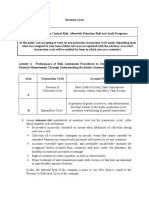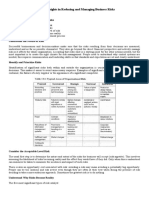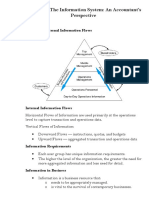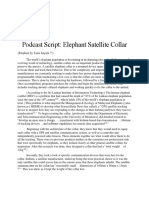Module 14
Module 14
Uploaded by
AstxilCopyright:
Available Formats
Module 14
Module 14
Uploaded by
AstxilOriginal Description:
Copyright
Available Formats
Share this document
Did you find this document useful?
Is this content inappropriate?
Copyright:
Available Formats
Module 14
Module 14
Uploaded by
AstxilCopyright:
Available Formats
Errors and Irregularities in the Transaction Cycles of the Business Entity
1. Errors in Recording Sales and Collections Transactions
Errors in recording sales include mechanical errors, such as using a wrong piece or wrong quantity, recording
sales in the wrong period (cutoff errors), a bookkeeper’s failure to understand proper accounting for a transaction,
and so on. Internal controls are designed to prevent or detect many of these kinds of errors.
2. Frauds in Sales and Collections
Frauds in sales generally relate to fraudulent financial reporting. In contrast, frauds in cash collections relate to
misappropriation of assets, typically accomplished by clerks or management-level employees.
a. Fraudulent Financial Reporting
Fraudulent financial reporting involving sales typically results in overstated sales or understated
sales returns and allowances.
Managers under pressure to achieve high profits may inflate sales to meet target profits established
by senior managers, to obtain bonuses, to retain the respect of senior managers, or even to keep
their jobs. The following methods can be used to increase sales fraudulently:
o Recording fictitious sales (creating fictitious shipping documents, sales invoices, and so on)
o Recording valid transactions twice
o Recording in the current period sales that occurred in the succeeding period (improper cutoff)
o Recording operating leases as sales
o Recording deposits as sales
o Recording consignments as sales
o Recording sales when the chance of a return is likely
o Following revenue recognition practices that are not in accordance with PFRS
o Recognizing revenue that should be deferred
b. Misappropriation of Assets: Withholding Cash Receipts
Skimming
o This refers to the act of withholding cash receipts without recording them. An example is
when a cashier in a retail store does not ring up a transaction and takes the cash. Another
example is when an employee who has access to cash receipts and maintains accounts
receivable records can record a sale at an amount lower than the invoice amount. When the
customer pays, the employee takes the difference between the invoice and the amount
recorded as a receivable. Detection of unrecorded cash receipts is very difficult; however,
unexplained changes in the gross profit percentage or sales volume may indicate that cash
receipts have been withheld.
Lapping
o This technique is used to conceal the fact that cash has been abstracted; the shortage in one
customer's account is covered with a subsequent payment made by another customer. An
employee who has access to cash receipts and maintains accounts receivable can engage in
lapping. Routine testing of details of collections compared with validated bank deposit slips
should uncover this fraud.
Kiting
o This is another technique used to cover cash shortage or to inflate cash balance. Kiting
involves counting the cash twice by using the float in the banking system. {Float is the gap
between the time the check is deposited or added to an account and the time the check clears
or is deducted from the account it was written on). Analyzing and verifying cash transfers
during the days surrounding year-end should reveal this type of fraud.
Acquisitions and Payments Cycle
1. Errors in the Acquisitions and Payments Cycle
The following may occur in the acquisitions and payments cycle:
• Failing to record a purchase in the proper period (cutoff errors)
• Recording goods accepted on consignment as a purchase
• Misclassifying purchases of assets and expenses
• Failing to record a cash payment
• Recording a payment twice
• Failing to record prepaid expenses as assets
Entities normally design controls to prevent these errors from occurring or to detect errors if they do occur. When such
controls exist, auditors test the controls to assess their effectiveness. If the controls are not effective, auditors should
perform substantive tests to determine that the financial statements do not contain material misstatements that arose
because of possible errors.
2. Frauds in the Acquisitions and Payments Cycle
a. Paying for Fictitious Purchases
This involves the perpetrator creating a fictitious invoice (and sometimes a receiving report, purchase order
and so forth) and processing the invoice for payment. Alternatively, the perpetrator can pay the invoice twice.
b. Receiving Kickbacks
In this scheme, a purchasing agent may agree with a vendor to receive a kickback (refund payable to the
purchasing person on goods or services acquired from the vendor). This is usually done in return for the
agent’s ensuring that the particular vendor receives an order from the firm. Often a check is made payable to
the purchasing agent and mailed to the agent at a location other than his or her place of employment.
Sometimes the purchasing agent splits the kickback with the vendor's employee for approving and paying it.
Detecting kickbacks is difficult because the buyer's records do not reflect their existence. However, when
vendors are required to submit bids for goods or services, the likelihood of kickbacks is reduced.
c. Purchasing Goods for Personal Use
Goods or services for personal use may be purchased by executive or purchasing agents and charged to the
company's account. To execute such a purchase, the perpetrator must have access to blank receiving reports
and purchase approvals or must connive with another employee. Fraud involving the purchase of goods for
personal use is more likely to go unnoticed when perpetual records are not maintained.
Payroll and Personnel Cycle
Historically, errors and irregularities involving payroll have been reported to occur frequently and are largely undetected.
1. Errors
The most errors that can occur in the payroll and personnel cycle are
a) paying employees at the wrong rate,
b) paying employees for more hours than they worked,
c) charging payroll expense to the wrong accounts, and
d) keeping terminated employees on the payroll.
Good internal control can be established to prevent these errors from occurring and to detect them if they do occur.
2. Frauds involving Payroll
The major payroll-related frauds include
a. Fictitious Employees
Adding fictitious employees to the payroll is one of the most common defalcations. Detecting fictitious
employees on the payroll is very difficult; but auditors do sometimes perform a surprise payoff as a deterrent
to this form of defalcation. Alternatively, the auditor may turn the check distribution over to an official not
associated with preparing payroll, signing checks, or supervising workers. Personnel files and the employees’
completed time cards and time tickets may also be examined to substantiate the existence of absent
employees.
b. Excess Payments to Employees
Increasing the rate above that approved or paying employees for more hours than they worked are the most
common ways of paying employees more than they are entitled to receive. These practices can be
substantially reduced by requiring personnel department officials to authorize changes in pay rates and by
monitoring total hours worked and paid for. Analytical procedures that focus on cost per unit of actual
production can also be helpful in detecting excess payments to employees.
c. Failure to Record Payroll
Companies having difficulty meeting profit targets or not-for-profit entities having difficulty managing costs
and expenses might fail to record a payroll. The omission of payroll can be difficult to hide unless a similar
amount of revenues or receipts has been omitted. Analytical procedures can be performed to test the
reasonableness of payroll cost.
d. Inappropriate Assignment of Labor Costs to Inventory
A company having difficulty meeting profit targets might assign to inventory labor cost that should have been
charged to expense. Analytical procedures such as comparing costs incurred to budgeted cost and verification
of valuation of inventory are some of the useful techniques in detecting such fraud.
You might also like
- 2024 Course Outline SIA 2Document3 pages2024 Course Outline SIA 2CAPINPIN SerelynNo ratings yet
- Nirvana and R Series 37kW-50HP To 250kW-300HP Modular Drive Troubleshooting Manual REV13 February 20121Document75 pagesNirvana and R Series 37kW-50HP To 250kW-300HP Modular Drive Troubleshooting Manual REV13 February 20121Eriton Cavalcanti100% (2)
- Module 2 Microsoft Word FeaturesDocument8 pagesModule 2 Microsoft Word FeaturesAstxilNo ratings yet
- Errors and Irregularities in The Transaction CyclesDocument39 pagesErrors and Irregularities in The Transaction CyclesE.D.J83% (6)
- Fraud ScenariosDocument7 pagesFraud ScenariosElvisPresliiNo ratings yet
- Process Industry Practices Coatings: PIP CTSL1000 Application of Internal LiningsDocument23 pagesProcess Industry Practices Coatings: PIP CTSL1000 Application of Internal LiningsSujita Sah100% (1)
- GOVBUSMAN MODULE 9 (12) - Chapter 15Document4 pagesGOVBUSMAN MODULE 9 (12) - Chapter 15Rohanne Garcia AbrigoNo ratings yet
- Group 4: Module 12: Errors and Irregularities in The Transaction Cycles of The Business EntityDocument35 pagesGroup 4: Module 12: Errors and Irregularities in The Transaction Cycles of The Business EntityApril Joy ObedozaNo ratings yet
- Governanace Chapter 15Document4 pagesGovernanace Chapter 15Loreen TonettNo ratings yet
- Group 4: Module 12: Errors and Irregularities in The Transaction Cycles of The Business EntityDocument6 pagesGroup 4: Module 12: Errors and Irregularities in The Transaction Cycles of The Business EntityApril Joy ObedozaNo ratings yet
- Week 16 - Errors and Irregularities in The Transaction Cycles of The Business EntityDocument4 pagesWeek 16 - Errors and Irregularities in The Transaction Cycles of The Business EntityNiña YastoNo ratings yet
- Chapter 15Document6 pagesChapter 15Joy RubioNo ratings yet
- MGT 209 - CH 15 Notes PDFDocument3 pagesMGT 209 - CH 15 Notes PDFMiks EnriquezNo ratings yet
- Topic 6 GermicDocument47 pagesTopic 6 Germiczymba dingNo ratings yet
- Group 5Document8 pagesGroup 5AstxilNo ratings yet
- Accounts Receivable FraudDocument5 pagesAccounts Receivable FraudTherese AtinyaoNo ratings yet
- Recording Valid Transactions TwiceDocument2 pagesRecording Valid Transactions TwiceLoreen TonettNo ratings yet
- Basics of Audititing - Compiled ResourcesDocument13 pagesBasics of Audititing - Compiled ResourceskmrakibulkabirrashikNo ratings yet
- Errors and Irregulari-Ties in The Transaction Cycles of The Business EntityDocument38 pagesErrors and Irregulari-Ties in The Transaction Cycles of The Business EntityClark Regin SimbulanNo ratings yet
- Audit of ReceivablesDocument24 pagesAudit of ReceivablesSheen Dela CruzNo ratings yet
- Objectives of AuditingDocument22 pagesObjectives of AuditingArjun M JimmyNo ratings yet
- How Do Different Levels of Control Risk in The RevDocument3 pagesHow Do Different Levels of Control Risk in The RevHenry L BanaagNo ratings yet
- Chapter 3 - Fraud, Ethics and Internal ControlsDocument6 pagesChapter 3 - Fraud, Ethics and Internal ControlsMichael AnibanNo ratings yet
- Material Auditing1 5Document86 pagesMaterial Auditing1 5Akshat RanaNo ratings yet
- Unit IDocument17 pagesUnit IThiri PhwayNo ratings yet
- Frauds and How They Are CommittedDocument9 pagesFrauds and How They Are CommittedSeb paulNo ratings yet
- Different Ways Frauds Are CommittedDocument7 pagesDifferent Ways Frauds Are CommittedSeb paulNo ratings yet
- Chapter 15Document8 pagesChapter 15Hannah Pauleen G. LabasaNo ratings yet
- Existence or Occurrence Completeness Rights and Obligations Valuation or AllocationDocument3 pagesExistence or Occurrence Completeness Rights and Obligations Valuation or AllocationReyes, Jessica R.No ratings yet
- Review Questions and Problems Chapter 7Document5 pagesReview Questions and Problems Chapter 7Chelle HullezaNo ratings yet
- Assgmt Fin STMT Fraud FinalDocument10 pagesAssgmt Fin STMT Fraud FinalOkwuchi AlaukwuNo ratings yet
- Chapter 5Document10 pagesChapter 5Rupesh SinghNo ratings yet
- FirrrDocument6 pagesFirrrFiraol MengistuNo ratings yet
- Identify An Internal Control Procedure That Would Reduce The Following Risks in A Manual SystemDocument2 pagesIdentify An Internal Control Procedure That Would Reduce The Following Risks in A Manual SystemArthenemis FortalejoNo ratings yet
- Common Fraud Scenarios GuideDocument10 pagesCommon Fraud Scenarios GuideGiancarlo Pajuelo CancceNo ratings yet
- Common Fraud Scenarios GuideDocument16 pagesCommon Fraud Scenarios GuideMaria Rona SilvestreNo ratings yet
- Module 2 Misstatement in The Financial StatementsDocument12 pagesModule 2 Misstatement in The Financial StatementsChristine CariñoNo ratings yet
- Auditing Part 3Document10 pagesAuditing Part 3Trisha BanzonNo ratings yet
- Auditing The Revenue CycleDocument2 pagesAuditing The Revenue CycleBella PatriceNo ratings yet
- Audit of CashDocument23 pagesAudit of CashmeseleNo ratings yet
- Reading Report: 1. Prepare A Summary For Each Business Process, NamelyDocument2 pagesReading Report: 1. Prepare A Summary For Each Business Process, NamelyAnita Noah MeloNo ratings yet
- ACCTG16A FinalExamDocument5 pagesACCTG16A FinalExamJeane BongalanNo ratings yet
- Erros Noah PDFDocument2 pagesErros Noah PDFAnita Noah MeloNo ratings yet
- Reading Report: 1. Prepare A Summary For Each Business Process, NamelyDocument2 pagesReading Report: 1. Prepare A Summary For Each Business Process, NamelyAnita Noah MeloNo ratings yet
- Errors and Irregularities in The Transaction CycleDocument22 pagesErrors and Irregularities in The Transaction CycleVatchdemonNo ratings yet
- Common Fraud Scenarios GuideDocument15 pagesCommon Fraud Scenarios Guideomar.saeedNo ratings yet
- IC3 Audit Procedures by Transaction Cycle Part 1Document12 pagesIC3 Audit Procedures by Transaction Cycle Part 1ReynaLyn TangaranNo ratings yet
- Fraud in Financial StatementDocument16 pagesFraud in Financial StatementMohammed AkhtarNo ratings yet
- NAMEDocument7 pagesNAMEMarinella LosaNo ratings yet
- FRAUDS AND ERRORS AND LEGAL REQUIREMENT OF AN AUDITDocument7 pagesFRAUDS AND ERRORS AND LEGAL REQUIREMENT OF AN AUDITmercymukoya097No ratings yet
- Trade PayablesDocument2 pagesTrade PayablesMeghaNo ratings yet
- FIN AC 1 - Module 4Document5 pagesFIN AC 1 - Module 4Ashley ManaliliNo ratings yet
- Auditing AssignmentDocument8 pagesAuditing AssignmentPhomolo StoffelNo ratings yet
- AUDITING Lecture NotesDocument26 pagesAUDITING Lecture Notesavinashtamang111No ratings yet
- Apc 301 Week 8Document2 pagesApc 301 Week 8Angel Lourdie Lyn HosenillaNo ratings yet
- Chapter 4 AssignmentDocument4 pagesChapter 4 AssignmentJo GreedyNo ratings yet
- Indicators FraudDocument2 pagesIndicators FraudBabatope OkeNo ratings yet
- 20 Ways To Detect Fraud: 1. Unusual BehaviorDocument4 pages20 Ways To Detect Fraud: 1. Unusual BehaviorayyazmNo ratings yet
- Fraud and Responsibilities of AuditorDocument35 pagesFraud and Responsibilities of AuditorSamratNo ratings yet
- Internal Audit and Budget Department - Cash ReceiptsDocument13 pagesInternal Audit and Budget Department - Cash ReceiptsMarineth Monsanto100% (1)
- Paper Tech IndustriesDocument20 pagesPaper Tech IndustriesMargaret TaylorNo ratings yet
- Errors and FraudDocument25 pagesErrors and Fraudmiam67830No ratings yet
- FINANCIAL AUDITING Discussion QuestionDocument8 pagesFINANCIAL AUDITING Discussion QuestionViệt LinhNo ratings yet
- Textbook of Urgent Care Management: Chapter 13, Financial ManagementFrom EverandTextbook of Urgent Care Management: Chapter 13, Financial ManagementNo ratings yet
- Introduction To Transaction Processing: A Financial Transaction Is..Document13 pagesIntroduction To Transaction Processing: A Financial Transaction Is..AstxilNo ratings yet
- Module 16Document3 pagesModule 16AstxilNo ratings yet
- Group 5Document8 pagesGroup 5AstxilNo ratings yet
- Module 15Document7 pagesModule 15AstxilNo ratings yet
- Chapter 5: The Expenditure Cycle Part 1: Purchases and Cash Disbursements ProceduresDocument7 pagesChapter 5: The Expenditure Cycle Part 1: Purchases and Cash Disbursements ProceduresAstxilNo ratings yet
- The Revenue Cycle: Journal Vouchers/EntriesDocument16 pagesThe Revenue Cycle: Journal Vouchers/EntriesAstxilNo ratings yet
- Unit 3Document4 pagesUnit 3AstxilNo ratings yet
- Module 11Document4 pagesModule 11AstxilNo ratings yet
- Module 13Document3 pagesModule 13AstxilNo ratings yet
- Module 12Document5 pagesModule 12AstxilNo ratings yet
- Ethics, Fraud, and Internal ControlDocument10 pagesEthics, Fraud, and Internal ControlAstxilNo ratings yet
- Unit 1Document8 pagesUnit 1AstxilNo ratings yet
- Chapter 1: The Information System: An Accountant's PerspectiveDocument10 pagesChapter 1: The Information System: An Accountant's PerspectiveAstxilNo ratings yet
- Module 1Document4 pagesModule 1AstxilNo ratings yet
- Unit 2Document5 pagesUnit 2AstxilNo ratings yet
- Module 6Document6 pagesModule 6AstxilNo ratings yet
- Module 5Document7 pagesModule 5AstxilNo ratings yet
- Module 2Document2 pagesModule 2AstxilNo ratings yet
- Module 4Document3 pagesModule 4Astxil100% (1)
- Module 7Document3 pagesModule 7AstxilNo ratings yet
- Module 1Document2 pagesModule 1AstxilNo ratings yet
- Module 1.5Document24 pagesModule 1.5AstxilNo ratings yet
- Module 5 EconDocument5 pagesModule 5 EconAstxilNo ratings yet
- Module 3Document2 pagesModule 3AstxilNo ratings yet
- MODULE 3 - Applied EconomicsDocument6 pagesMODULE 3 - Applied EconomicsAstxilNo ratings yet
- Economics: History, Importance and Branches: MODULE 1 - EconDocument6 pagesEconomics: History, Importance and Branches: MODULE 1 - EconAstxilNo ratings yet
- Module 4 EconDocument5 pagesModule 4 EconAstxilNo ratings yet
- Nature and ArtDocument1 pageNature and ArtAstxilNo ratings yet
- Module 2 EconDocument6 pagesModule 2 EconAstxilNo ratings yet
- 2nd LAW THERMO2Document6 pages2nd LAW THERMO2Ervin MogarNo ratings yet
- DennyDocument5 pagesDennyGodwin GodwinNo ratings yet
- Course Summary ReportDocument4 pagesCourse Summary Reportvicky guptaNo ratings yet
- B37690A OM Easygen-1800 DDocument36 pagesB37690A OM Easygen-1800 DDieinathon BentoNo ratings yet
- The Following Constitute The Practice of Medicine: (1-4 PE) (POTS-DF)Document23 pagesThe Following Constitute The Practice of Medicine: (1-4 PE) (POTS-DF)Michael DonascoNo ratings yet
- Nihil Est in Intellectu Quod Non Prius in SensuDocument5 pagesNihil Est in Intellectu Quod Non Prius in SensuMary-Rose CasuyonNo ratings yet
- CHAPTER 1 The Teacher and The Community The School Culture and Organizational Leadership NewDocument34 pagesCHAPTER 1 The Teacher and The Community The School Culture and Organizational Leadership NewTres Marias100% (2)
- The Eversion of Kathak PDFDocument77 pagesThe Eversion of Kathak PDFYounjin ChoiNo ratings yet
- Section 14.1 Functions of Several VariablesDocument6 pagesSection 14.1 Functions of Several VariablesAlvin AdityaNo ratings yet
- Human Relation TheoriesDocument4 pagesHuman Relation TheoriesAlonkrita BoseNo ratings yet
- Young Muslims Personal Collective Development PlanDocument24 pagesYoung Muslims Personal Collective Development PlanAmericans for Peace and ToleranceNo ratings yet
- Research Article Plasmodium FalciparumDocument5 pagesResearch Article Plasmodium FalciparumIsmail IkhsanNo ratings yet
- CH 03Document122 pagesCH 03Rakhma RamadhaniNo ratings yet
- MC Tanque 15 Mil Bls Rev 02Document104 pagesMC Tanque 15 Mil Bls Rev 02maurizio109No ratings yet
- Dirty Old Man's Cookbook - Honest JohnDocument124 pagesDirty Old Man's Cookbook - Honest JohnRichard Ranges GarciaNo ratings yet
- Unit Assessment Plan MorelandDocument2 pagesUnit Assessment Plan MorelandEric MorelandNo ratings yet
- The Hollow of Three Hills by Nathaniel HawthorneDocument7 pagesThe Hollow of Three Hills by Nathaniel Hawthorneayeshabatool.saqiNo ratings yet
- Dahua Marketing Material Guide - 20220418Document91 pagesDahua Marketing Material Guide - 20220418Antonio FormicaNo ratings yet
- Name: Christine Ndanu ADMISSION NO: BBM/2041 /18 Unit: Total Quality in Supply Chain Management Unit Code: BBM 445 Assignment: CatDocument4 pagesName: Christine Ndanu ADMISSION NO: BBM/2041 /18 Unit: Total Quality in Supply Chain Management Unit Code: BBM 445 Assignment: CatHashi MohamedNo ratings yet
- Epicycloid Wikipedia 1675716594505Document12 pagesEpicycloid Wikipedia 1675716594505Jafar EarlNo ratings yet
- English 9th Full NotesDocument19 pagesEnglish 9th Full Noteszkk.lhrNo ratings yet
- Safo 06016Document3 pagesSafo 06016AVRO AVRONo ratings yet
- The Key To Classroom ManagementDocument12 pagesThe Key To Classroom Managementchris orlanNo ratings yet
- Podcats ScriptDocument3 pagesPodcats ScriptMina DedijerNo ratings yet
- CG Power Systems Canada Eng EnglishDocument6 pagesCG Power Systems Canada Eng EnglishpitambervermaNo ratings yet
- Injuriesharms Resulting From Incorrect Adjustmentsalignments Performed by Yoga Asana PractitionersDocument10 pagesInjuriesharms Resulting From Incorrect Adjustmentsalignments Performed by Yoga Asana PractitionerssimonyanNo ratings yet
- Dasypus Novemcinctus,: Assessment By: Loughry, J., Mcdonough, C. & Abba, A.MDocument11 pagesDasypus Novemcinctus,: Assessment By: Loughry, J., Mcdonough, C. & Abba, A.Mnatalia chamorro solorzanoNo ratings yet






















































































































